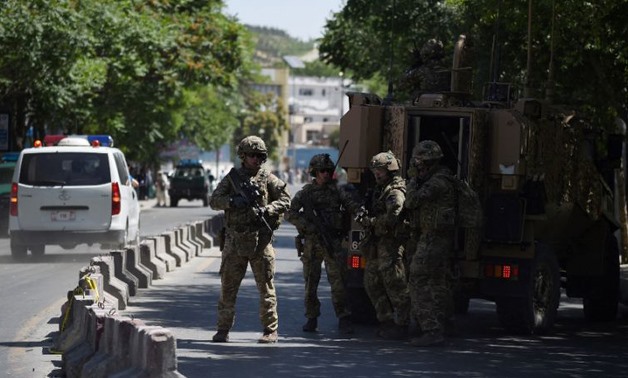
US soldiers at the site of a car bomb in the Afghan capital Kabul on May 31, 2017 - AFP
Washington - 14 June 2017: President Donald Trump has granted the Pentagon authority to set troop levels in Afghanistan, a US official said Tuesday, a move that could lead to the deployment of thousands more soldiers.
Speaking on condition of anonymity, the official told AFP that Pentagon chief Jim Mattis can now directly adjust troop numbers, though the official would not confirm whether a new "force management level" -- currently at around 8,400 -- had been finalized.
"The White House has done the same that it did with Iraq and Syria, which is to grant the secretary of defense the authority to set troop levels," the official said, referring to recent adjustments Trump has approved for the fight against the Islamic State group in those two countries.
Under Barack Obama, troop levels in Afghanistan, Iraq and Syria were closely managed by the White House and commanders complained they felt shackled by the strictures.
The development came just hours after Mattis gave lengthy testimony to lawmakers, some of whom were exasperated at how long it has taken for Trump to come up with a new strategy in Afghanistan.
The official said the final decision to give Mattis the power to adjust troop levels actually came during his testimony, at which he said America still is "not winning" in Afghanistan.
The "Taliban had a good year last year, they are trying to have a good one this year," Mattis told the Senate Armed Services Committee at a hearing about the Pentagon's budget.
"Right now, I believe the enemy is surging."
Mattis's latest assessment comes nearly 16 years after the US-led invasion of Afghanistan and amid a war that continues to claim the lives of US troops each year -- and those of thousands of local forces and civilians.
US military commanders, who saw fragile security gains eroded under Obama-era troop drawdowns, have been pushing for a new strategy that could see thousands of additional soldiers deploy to Afghanistan to help train and advise beleaguered Afghan partners.
Media reports have said Mattis is considering asking for 3,000 to 5,000 additional US and NATO troops, but the defense chief has said little on the matter.
In February, General John Nicholson, who commands NATO forces in Afghanistan, warned that he needs "a few thousand" more troops to reverse what he called a stalemate.
Despite months of expectation that a full Afghanistan strategy announcement is imminent, Mattis said the new plans not be ready before mid-July.
Republican Senator John McCain, who chairs the Senate Armed Services Committee, voiced his "palpable" frustration.
"We're now six months into this administration, we still haven't got a strategy for Afghanistan," McCain said, noting it was difficult to get behind an Afghanistan budget request without knowing what the plan is.
"We know what the strategy was for the last eight years: Don't lose. That hasn't worked."
Mattis acknowledged the reality on the ground.
"We are not winning in Afghanistan right now. We will correct this as soon as possible," he said.
- Residual force -
The defense chief, who was a Marine combat commander in Afghanistan at the start of the war, stressed America must not walk away from the country and suggested a long-term residual US force needs to remain to help the Afghan army maintain a baseline of security.
"It's going to be an era of frequent skirmishing and it's going to require a change in our approach from the last several years if we're to get it to that position," Mattis said.
The Afghan conflict is the longest in American history, with US-led NATO troops at war there since 2001, after the ousting of the Taliban regime just months after the September 11 terror attacks in the United States.
The ongoing security crisis has seen not just the Taliban gain ground, but also the emergence of other groups such as a local Islamic State affiliate.
On Saturday, the Taliban claimed responsibility for an insider attack in which an Afghan commando turned his weapon on American troops, killing three and wounding another.
US troops in Afghanistan number about 8,400 today, and there are another 5,000 from NATO allies, who mainly serve in a training and advisory capacity.

Comments
Leave a Comment